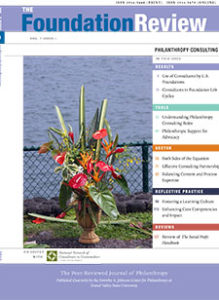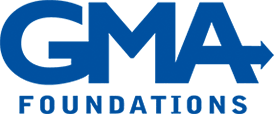By nature, family philanthropy is a deeply meaningful and evolving endeavor. Families are notoriously unique in their approaches to giving together, yet there are common stages and transitions that all family foundations experience. The foundation life cycle is a useful lens for understanding these stages, for seeking outside expertise, and for setting the stage for successful transitions.
Mission-ready Family Foundation
Every family foundation has its own history, challenges, and sources of pride. Foundation leaders may describe their organizations using indicators such as asset size, budget, the number of staff, and years of existence. While these common indicators point to organizational capacity and may inform some decision making, they do not describe the organization’s stage of development or readiness to achieve its mission or create social change.
 The life cycle is one way to gauge that readiness.
The life cycle is one way to gauge that readiness.
As consultants to family foundations, we looked into how the life-cycle concept could help guide foundation leadership in anticipating change and in engaging outside expertise to navigate transitions. We surveyed foundation leadership, consulted with researchers, and compiled their stories and our combined recommendations in the Foundation Review article, The Family Foundation Life Cycle and the Role of Consultants.
We encourage boards and donors to consider their outlook on giving and readiness for the future. Build a shared vocabulary using the life-cycle framework, knowing that no giving program cycles through stages in a linear way. The simple framework is a tool for deep conversation.
Prepare for successful transitions
Our conversations with family foundation leaders in our practice and in our research consistently point to the critical nature of timing, fit, and clarity in managing a dynamic organization as it evolves. These three factors underlie this recommended process for preparing to engage outside expertise to help navigate your foundation’s anticipated transitions:
-
Know Your Life-Cycle Stage
How would you characterize your foundation or giving program’s readiness to achieve your mission? Develop a vocabulary that describes your aspirations, achievements, and capacity. Use this understanding as the basis for conversations with colleagues, family, and advisors about anticipating change and planning for success.
The Life-Cycle Framework
| Starting up |
|
| Growing |
|
| Maturing |
|
| Stationary |
|
| Renewing |
|
| Ending |
|
Just as families with small children may find common ground with their peers, and face different challenges than empty nesters, family foundations in similar life-cycle stages may share some fundamental opportunities and challenges. In addition to self-awareness around the foundation’s life cycle, timing is an important consideration when planning for and engaging outside expertise.
One foundation leader interviewed echoed this idea quite simply, “the engagement and consultant selected should be relevant to where the foundation is in its life cycle.”
Reflect:
- What best describes our life-cycle stage?
- What milestones are on the horizon?
- What are our primary goals and main concerns?
2. Agree upon the foundation’s needs
Foundations that know who they are and what they need set the stage for successful consulting engagements. Before identifying the right consultant, the foundation board and leadership staff should first have a clear and uniform understanding of what they would like to achieve and whether a particular skills set, personality type, or level of experience is needed. A consultant who listens and understands the foundation’s ideas, questions, concerns, anxieties and decision-making style is likely to be a good fit. If a foundation is unable to articulate its needs, the consultant may translate what she hears into what she thinks the foundation needs based upon her own experience and expertise, which may or may not result in the right fit.
Define the foundation’s needs:
- Explore common consultant engagement points
- Articulate where we want to be in five or ten years
- Draft priorities for the coming year
Rely on this clear understanding of the foundation’s current and upcoming needs in conversations with consultant referral sources, consultant candidates, and a consultant’s professional references. For example:
- A foundation in its start-up life-cycle stage needs a consultant who knows the right questions to ask in order to engage the board in determining mission and considering values and goals. It will benefit from engaging a consultant with strong experience with foundation management, a range of governance structures, and the everyday aspects of running a grantmaking program.
- A foundation in a growth phase will want to consider consultants with experience in the functional and emotional aspects of transition. In a renewal phase, where the foundation is reflecting on impact in order to adjust focus or develop a new direction, a consultant with content expertise would be a good fit.
3. Find the right “fit” based on skills, experience, and personality
Survey respondents and interviewees who were pleased with their consulting engagements often offered a variation on the “good fit” theme. One survey respondent who ranked the engagement as “excellent” captured this idea and the ultimate aim: “The consultant was a great fit and worked well with us to accomplish our goals.” In contrast, a “bad fit” can doom a consulting engagement.
Questions family foundations can ask, related to fit, include:
- Does our board respond better to a commanding presence or a collaborative approach?
- Does the consultant need extraordinary amounts of patience and persistence, or perhaps the ability to engage with differing personalities?
- Is cultural competency a concern?
- Do we need a facilitator, a process consultant, a content expert, a strategic planner?
4. Establish clear goals for the project and for the future
While some of our interview subjects offered conflicting advice to others hiring consultants, all recommended “clarity” and/or specific “goals.” Whether or not there is a formal contract, written agreements can help set the stage for success.
The actual consulting process is only the beginning of achieving a foundation’s objectives, and should be tied into a plan for what comes next. The life-cycle lens may illuminate your conversations from anticipating change to implementing action plans .
——————-
We welcome your thoughts on the life cycle as a useful lens for foundations planning for the future. Contact Susan Barry, CEO, sbarry@gmafoundations.com
